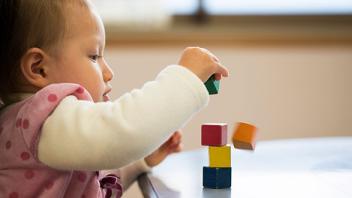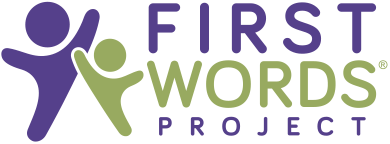Research shows children learn by doing. Discovering what they can do with objects leads to learning to talk and to pretend, which then launches imagination. Children should be learning at least two new actions with objects each month from 9 to 16 months. By 16 months, children should use at least 16 actions with objects.
Babies are natural explorers and are motivated to learn from birth. Their drive for learning comes from their fascination with everything that captures their attention.
Toddlers are “movers and shakers” — always on the go. They seek information about the world. They experiment to figure out how things work. Their enthusiasm to share their experiences and accomplishments is contagious.
Children should learn at least 16 actions with objects by 16 months
My Baby Navigator
When you join My Baby Navigator, you’ll have access to resources and tools that are customized for your baby’s age and grow as your baby grows to help monitor development — birth to 24 months. From Lookbooks to Growth Charts, from Monthly Check-Ins to our Social Communication CheckUp, from Printables to Web Resources — all in one place that you can access online from anywhere anytime.
9 months: mouth, bang, drop
At 9 months, babies repeat different actions with objects. They mouth objects to explore the features. They bang objects with their hand and bang two objects together to create sounds and actions. They drop objects sometimes by chance and other times on purpose.
10 months: take off, take out
At 10 months, babies learn to grab and pull and take things off, like a sock, shoe, or hat. They grab and pull to take a towel off their head and play peek-a-boo. Babies are drawn to see what’s in an open drawer and take things out to explore.
11 months: push, turn
At 11 months, babies learn to push. They can push and squish soft stuff or push hard things, like a piano key to make a musical sound and a button on a toy phone or pop-up toy. They can push a toy train to make it move or a tower of cups to knock it down.
Babies learn to turn things. They can turn a ball on their toy mobile, a steering wheel on a toy car, or the faucet in the tub. They can turn a page in a book. And they can turn a basket upside down, put it on their head, and make you laugh.
12 months: pat, put in
At 12 months, babies learn to pat. They can pat themselves with a towel to dry off or pat their Teddy bear. Soon, their pat develops into a hug to share their love. Babies are learning functional actions with a purpose in mind. They can put things in, such as put clothes in the dryer or a shape in a puzzle. From “put in” they learn a variety of functional actions. They can put a sippy cup to their mouth to drink, a spoon in a bowl to scoop, and a spoon in their mouth to eat.
13 months: feed others, open and close
At 13 months, children begin to learn by observing others and copying what they do and say. They can feed Mom with a cup or teddy bear with a bottle, showing they are on the cusp of pretending.
They open and close objects as they learn to use objects as tools. They try to open and close tongs and clothes pins. Toddlers can open and close cupboards and oven doors. As they become more mobile, nothing is out of reach. You can harness this interest by inviting them to do things that are safe and helpful — like open the dishwasher and take out forks and spoons.
14 months: move objects back and forth, up and down
At 14 months, toddlers learn to move objects back and forth. They can help to brush their teeth and hair. They can push a toy back and forth and pretend they are vacuuming, try to roll a ball to you, and try to help push a rolling pin back and forth.
They learn to move objects up and down and try to cut things, real and pretend. They jiggle a pan to pretend to cook. They move drum sticks up and down, experimenting with sounds and rhythms.
15 months: pour, wash, and dry
At 15 months, children are learning to use two objects together with a plan in mind. They can pour from one object to another, such as liquid from a bottle into a cup. They can pour from a shovel into a bucket and from a watering can onto plants.
With a plan in mind, they can help wash and dry dishes and even the car. Toddlers are eager for a role in family chores.
16 months: stack, cut out, scribble, draw
At 16 months, children can make and create things. They can stack 3 or 4 blocks to make a tower. They can make a bigger tower with blocks that connect, and rings on a pole. They can cut out dough to help make cookies. They can cut out Playdoh shapes and put them together to make a creature. Children are learning how to create drawings. They can scribble with a crayon and paint with a paint brush. With a little help and practice, they try to draw with colored pencils.
Having 16 actions with objects is a critical milestone to launch imagination
Watching how a child’s actions with objects grow tells you a lot about their development in play — and whether to be concerned if they are not yet talking. The actions a child learns vary depending on their family or culture. But having 16 actions with objects by 16 months is a critical milestone for all children because it launches imagination, and that fuels language learning. By their second birthday, children learn to use words and phrases to describe, inquire, and negotiate with others. It’s this ability to talk, imagine, and create new ideas that sets the stage for lifelong learning.
The best time to get ready for preschool is from 9 to 16 months
The richest moments for early language learning are when a child and caregiver share attention on the same thing and the caregiver talks about the child’s focus of attention. This creates opportunities to learn that stem from actions with objects … and gestures. By observing early actions with objects and gestures between 9 and 16 months, you can get a critical snapshot of what a child knows and is thinking about.
If a child is not using a variety of actions with objects and gestures from 9 to 16 months, then the parent may not have the chance to respond and follow the child’s focus. This limits the child’s opportunity for the richest moments to learn to talk. Spotting small gaps in early actions with objects and gestures from 9 to 16 months is the best time to get ready for preschool so children can reach their potential by kindergarten.
Want to learn more? Subscribe!
FIRST WORDS® Project is a longitudinal research investigation in the Florida State University Autism Institute, directed by Dr. Amy Wetherby. Our goal is to identify early signs of communication delays in young children by improving screening tools and helping families support child development. Copyright © 2019 Florida State University. All rights reserved.
Developed by the FIRST WORDS® Project. www.firstwordsproject.com
© 2018 Florida State University. All rights reserved.

